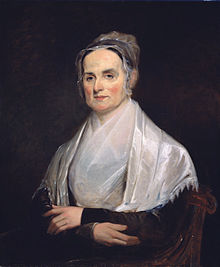Seneca Falls Convention
The Seneca Falls Convention was the first gathering of American women to focus on women's rights . It was not the first meeting to deal with this issue at all, but it was a women-organized meeting devoted exclusively to women's rights as such. It was held in the western part of New York State, in the small town of Seneca Falls, New York , on July 19-20, 1848. In the end, a famous manifesto was issued, the Declaration of Sentiments .
prehistory

Elizabeth Cady Stanton and her newlywed husband had made a long trip to the World Anti-Slavery Convention of the British and Foreign Anti-Slavery Society in 1840, it was their honeymoon, and together with other followers of abolitionism . There they saw that despite a debate that lasted for days on the subject of “women's participation in the Congress”, these were not allowed. They were not allowed to speak or vote, they were only allowed to listen from the gallery. On that occasion, Stanton and Quaker Lucretia Mott became friends and vowed to hold a women's rights conference back in the States. It then took around eight years before the opportunity arose.
Local Quakers , together with Elizabeth Cady Stanton, who was not a Quaker, organized this meeting in Seneca Falls, especially in the local Wesleyan Methodist Church. They planned this event on a fairly short notice so that Philly-born Quaker Lucretia Mott could attend while visiting western New York State. Mott was famous for her ability to speak, which was otherwise rare in women. Because during this time women were not often allowed to speak in public.
Course of the meeting
The meeting on 18./19. July 1848 consisted of six sessions, including a lecture on law, a humorous presentation and a multiple discussion about the role of women in society. Stanton and the Quakers came up with two prepared documents, the Declaration of Sentiments and an accompanying list of resolutions that were to be debated and amended before being submitted for signature.
A heated debate arose over the treatment of the right to vote for women, which was particularly close to Stanton's heart. Many, including Mott, pushed for this concept of women's suffrage to be eliminated. But Frederick Douglass , who participated alongside other men and was the only African-American , argued convincingly in favor of keeping it. In the end exactly 100 of the 300 or so people present signed the document, most of them women.
Effects
This first meeting on women's suffrage, after attracting widespread attention, was supplemented and continued by a second meeting two weeks later. It was at the Rochester Women's Rights Convention of 1848 in Rochester, New York , that for the first time a woman alone presided over the sessions of a congregation consisting of men and women. From 1850 on, a series of national women's rights conventions followed, which took place annually until 1861 in Worcester, Massachusetts .
The Seneca Falls Convention was seen by contemporaries, including the speaker Mott, of course, as an important step among many others in the ongoing endeavor of women to gain a greater share of social, civil and moral rights.
Others saw this gathering as revolutionary, as the beginning of women’s struggle for full equality with men. Stanton herself saw it as the beginning of the women's rights movement, at least that's how she published it in her work on the women's rights movement.
Declaration of Sentiments
The Declaration of Sentiments , the manifesto of the gathering, was described by Judith Wellman, a historian, as "the single most important factor in spreading news of the women's rights movement around the country in 1848 and into the future" (the most important factor in the Spread of the women's rights movement across the country, both in 1848 and afterwards)
Before the list of "sentiments", the perceived injustices, begins, Stanton formulated the following famous sentence:
The history of mankind is a history of repeated injuries and usurpations on the part of man toward woman, having in direct object the establishment of an absolute tyranny over her. To prove this, let facts be submitted to a candid world: - (The history of mankind is a consequence of repeated injustices and assaults on the part of men against women, with the clear intention of establishing absolute tyranny over them to prove, facts are to be presented to the well-meaning public :)
literature
- Tetrault, Lisa. The Myth of Seneca Falls: Memory and the Women's Suffrage Movement, 1848–1898 (2014) online review The review will be downloaded as a PDF.
- Wellman, Judith. The Road to Seneca Falls: Elizabeth Cady Stanton and the First Women's Rights Convention , University of Illinois Press, 2004. ISBN 0-252-02904-6
Web links
- Report on the Seneca Falls Women's Rights Assembly on July 19/20, 1848. Retrieved September 30, 2018
- Section 1: The Seneca Falls Women's Rights Convention and the Origin of the Women's Rights Movement In- depth treatise on the Seneca Falls Convention, its myth, and the origins of the women's rights movement, accessed September 30, 2018


